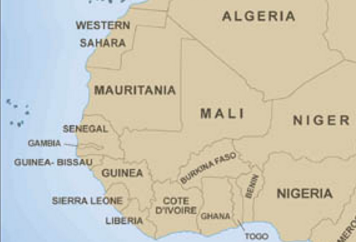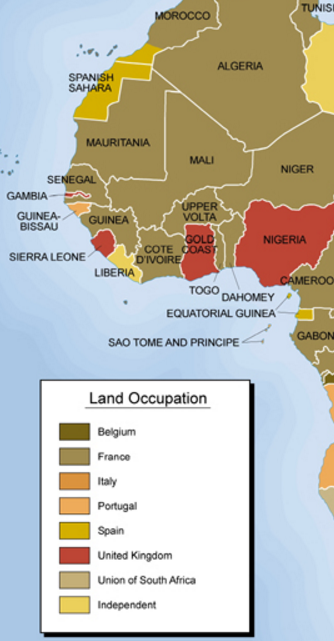What is West Africa?
The Problem of Drawing Borders in Africa
No matter where you are talking about in the world, regions, borders, and groupings on a map are never inherent or fixed for all time. They are categories created by geographers or other people that grow out of a number of factors. These factors can be political, economic, cultural, linguistic, and/or geographical.
For example in the map below, the mapmaker has labeled language groups for each country in West Africa. Yet in reality, this map greatly simplifies the number of languages in West Africa and where they can be found. As an example, find Hausa on the map below. It is listed as a major language group in Niger and Nigeria, yet Hausa speakers can be found in countries all over West Africa. Also look at all the languages listed for Niger and Nigeria. What are they? Did you know that Yoruba, Hausa, Igbo, Fulfulde, and Zarma are only a few of many languages spoken in these countries? What’s more, we must also consider how the languages spoken in West Africa have changed throughout history when looking at this map. The language categorizations here reflect the situation today. But people have always been migrating to the African continent as well as migrating within it. If we go back far enough in history, this language map would look very different. As we can see from this example, regional groupings and divisions, such as those on the map below, are useful to a certain extent, but they also only tell part of the story. This is important to keep in mind as we talk about West Africa as a region throughout this module.
Languages of West Africa
Drawing borders for West Africa
When people talk about West Africa, they are usually referring to a group of countries that exist today and are found in the northwestern region of the African continent. The map below shows those countries that are usually considered part of West Africa. While some people occasionally include other countries in the region of West Africa, the countries on the map below are the most common grouping. Fifteen of them make up an organization called ECOWAS (Economic Community of West African States). The sixteenth country, Mauritania, used to be a part of ECOWAS, but withdrew in December 2000. Nevertheless, we have included it in the grouping of West African countries for this lesson.
WEST AFRICA
As you will remember from Module Seven on African history, political borders in Africa have changed substantially over time. How then did the countries that make up West Africa come to be grouped together into a region? How is this categorization of countries useful? How is it limiting?
A few things that tie West Africa together as a region…
1. Geography
The northern border of West Africa is the Sahara desert. This is a sparsely populated region that is difficult to live in or travel through due to extreme heat and minimal food and water. Thus people tend to live and travel above (North Africa) or below (West Africa) the Sahara. This creates a natural divide between the two regions. To the west and south of West Africa sits the ocean. This serves as another natural border. And in the southeastern corner of West Africa are the Cameroonian Mountains and highlands that lie along the border between Cameroon and Nigeria.
2. Former Kingdoms of West Africa
In Unit 2, Module 7A, Activity 3: History of Africa during the time of the great West African kingdoms, we studied some of the West African kingdoms. These include the Ghana Kingdom (9th to 13th centuries), Mali Kingdom (13th to 15th centuries), and Songhay Kingdom (1350-1600). In the map below, you will also notice other kingdoms and empires of West Africa. These political entities, which existed before the colonial period, facilitated economic, political, religious, and social relations over vast areas of West Africa.
West African Kingdoms & Empires
3. Colonialism
Several European countries colonized West Africa during the late 19th and early 20th centuries, although West African relations with Europe go back much farther in history than this through contact with traders (some of whom were trading slaves), missionaries, explorers, and private European companies. Most West African countries were colonized by either the British or French, although the Portuguese and Germans also held some land at times in this region. The map below shows which European countries were the colonizing powers for each West African country in 1945. Note that only Liberia was not colonized by a European country at this time. We will return to the situation in Liberia later in Activity Four.
One result of the colonial experience in West Africa is that French and English emerged as common languages that the region shared. European colonizers also grouped together large parts of West Africa into political entities, such as French West Africa, which was governed by the French from Dakar (the capital of present day Senegal) for a time. Included in this region is what are today Senegal, Mali, Guinea, Burkina Faso, Côte d’Ivoire, Benin, Niger, and Mauritania. Connections between these countries based on the French colonial experience continue up to today. For example, most of these countries share a common currency called the CFA (Communauté Financière Africaine) franc, which until recently was tied directly to the value of the French franc.
4. ECOWAS
Largely in response to external European domination during and following the colonial period in Africa, numerous regional integration schemes emerged to challenge these external powers. One such organization that emerged in West Africa is ECOWAS (Economic Community of West African States). It was created in 1975 and still exists today. Included are the 15 West African countries (formerly 16 before Mauritania withdrew) at the beginning of this activity. Each member state has two representatives who serve on the ECOWAS Council of Ministers. ECOWAS has a tribunal and five commissions, which are:
1. Trade, Customs, Immigration, Monetary, and Payments
2. Industry, Agriculture, and Natural Resources
3. Transport, Communications, and Energy
4. Social and Cultural Affairs
5. Administration and Finance
To learn more about ECOWAS, visit its website at http://www.ecowas.int/.
A Few Ways in Which Thinking of West Africa as a Region is Limiting…
1. The multiculturalism within West Africa may not be emphasized enough.
Just because countries and people within West Africa are grouped together into a category does not, of course, mean that they are all the same. West Africa is an extremely culturally and linguistically diverse place. Nigeria, for example, has 507 languages that are currently spoken in that country alone. People of West Africa do not all share the same religion, cultural traditions, physical surroundings, or standards of living either.
2. People in West Africa have strong ties to groups across the globe.
Sometimes people in a certain region like West Africa feel more connected to people in other parts of the world than they do to some of the people in their own region. This can be because certain West Africans often share a common language, religion, culture, or economic and political alliance with people outside West Africa. This is not surprising in this day and age when people frequently move around the globe and are able to communicate over long distances through email, telephone, or television.
Go on to Activity Two or select from the other activities in this module:




